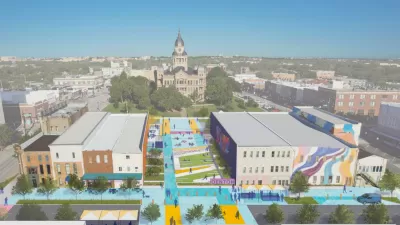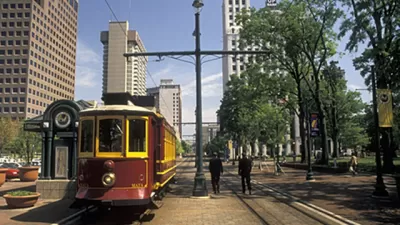Landscape Architecture Magazine looks at the design behind the new downtown art park in St. Louis and calls it a "hybrid oasis" in the city.
George Hazelrigg, ASLA, offers this detailed look at the park's design and development in a historically underutilized and forgettable plot of downtown real estate.
"The city's regional geography, notably its two great rivers-the Mississippi and the Missouri-and their tributaries and limestone outcrops, informed the design from the beginning, as did the downtown's urban grid and mapped reminders of earlier property lines, building foundation walls, and alleyways. During an on-site interview last July, Byrd said that one lesson learned from the experience was not to try to force your design, but rather to look as deep as you can into the locale and the region. 'If you bring these out,' he said, 'you can do some pretty remarkable things.'
Early on, the design team decided on a tripartite division of the garden into east–west bands. The northern 'river bluffs' band consists of a series of urban terraces beginning at the site's eastern end, where the park's café extends into a terrace with pool overlooking the lower garden. It ends at the site's highest point, a 'mound' reaching 10 feet above street level at the western end and covered with 70 river birch trees."
FULL STORY: Creating an Urban Oasis

Study: Maui’s Plan to Convert Vacation Rentals to Long-Term Housing Could Cause Nearly $1 Billion Economic Loss
The plan would reduce visitor accommodation by 25,% resulting in 1,900 jobs lost.

North Texas Transit Leaders Tout Benefits of TOD for Growing Region
At a summit focused on transit-oriented development, policymakers discussed how North Texas’ expanded light rail system can serve as a tool for economic growth.

Why Should We Subsidize Public Transportation?
Many public transit agencies face financial stress due to rising costs, declining fare revenue, and declining subsidies. Transit advocates must provide a strong business case for increasing public transit funding.

How to Make US Trains Faster
Changes to boarding platforms and a switch to electric trains could improve U.S. passenger rail service without the added cost of high-speed rail.

Columbia’s Revitalized ‘Loop’ Is a Hub for Local Entrepreneurs
A focus on small businesses is helping a commercial corridor in Columbia, Missouri thrive.

Invasive Insect Threatens Minnesota’s Ash Forests
The Emerald Ash Borer is a rapidly spreading invasive pest threatening Minnesota’s ash trees, and homeowners are encouraged to plant diverse replacement species, avoid moving ash firewood, and monitor for signs of infestation.
Urban Design for Planners 1: Software Tools
This six-course series explores essential urban design concepts using open source software and equips planners with the tools they need to participate fully in the urban design process.
Planning for Universal Design
Learn the tools for implementing Universal Design in planning regulations.
City of Santa Clarita
Ascent Environmental
Institute for Housing and Urban Development Studies (IHS)
City of Grandview
Harvard GSD Executive Education
Toledo-Lucas County Plan Commissions
Salt Lake City
NYU Wagner Graduate School of Public Service




























